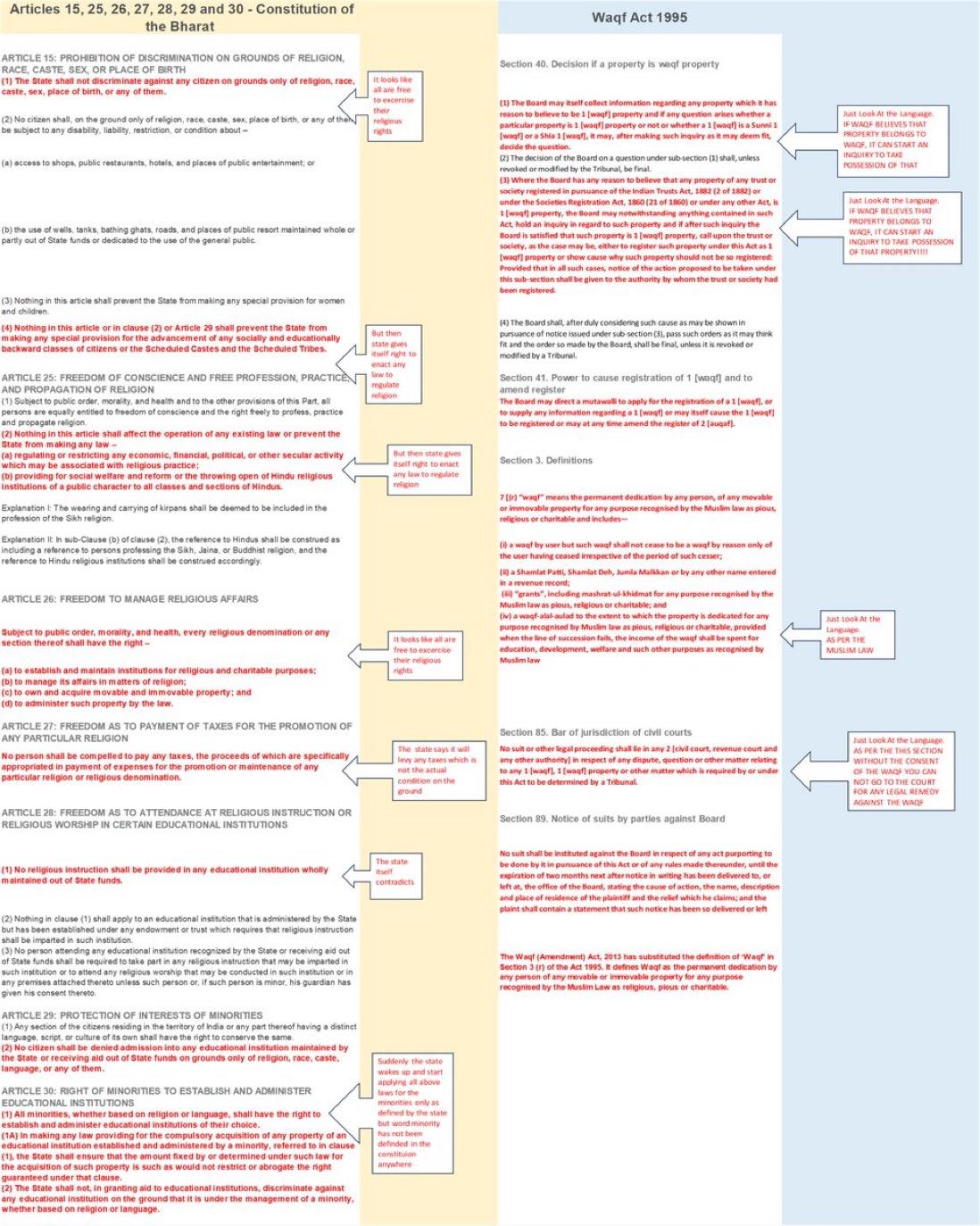Waqf Act - A tool of land grabbing given by the Indian National Congress to the Muslims of the Bharat
1. The Hindus who came to India after partition from Pakistan, their properties in Pakistan were occupied by the Muslims and the Government of Pakistan. But the Government of India gave the land of Muslims who went from India to Pakistan to the Waqf Boards. After which the Waqf Board Act was passed in the year 1954. But in the year 1995, by changing the Waqf Board Act, the Waqf Boards were given unlimited rights to acquire land. After which the property of the Waqf Board increased. In the year 2009, the properties of the Waqf Board were spread over four lakh acres of land. Which has now more than doubled. According to the data of Waqf Management System of India, at present there are a total 8,54,509 properties with Waqf Boards which are spread over more than eight lakh acres of land. You will be surprised to know that after the Army and Railways, LARGEST LANDBAK is with the Waqf Boards.
2. The acquisition of land by the Catholic Church of India worth more than 20,000 crores, can be attributed mainly to the Indian Churches Act of 1927, which was implemented during the British dominion. Under this act, the British dominion leased the lands acquired through their conquests in various wars at discounted rates to aid in the propagation of Christianity among the populace. This enabled the Church to acquire land across India and establish numerous institutions, including religious ones, as mentioned earlier, to disseminate their message to the masses. However, the legal status of this land acquisition remains a topic of debate.
3. The Sikh Gurdwaras Act 1925 was passed by the Punjab legislative council in British India to resolve a dispute over the management of Sikh gurdwaras. The law legally defined Sikh identity and brought Sikh gurdwaras under the control of an elected body of orthodox Sikhs. As per this act any structure notified by the government as Gurudwara shall fall under the definition provided in this act along with all the properties associated with the notified structure as Gurudwara.
4. So what about Hindu temples and religious places.
Let's us explore, how Nehru and Congress did their best to wreck the Hindu Temples and their cultural heritage by creating articles in the constitution of the Bharat to give free hand to the minorities especially waqf board and the Catholic church to amass a billion-dollar empire of the properties without any abandon.
Copied from X the storyteller
1. The Hindus who came to India after partition from Pakistan, their properties in Pakistan were occupied by the Muslims and the Government of Pakistan. But the Government of India gave the land of Muslims who went from India to Pakistan to the Waqf Boards. After which the Waqf Board Act was passed in the year 1954. But in the year 1995, by changing the Waqf Board Act, the Waqf Boards were given unlimited rights to acquire land. After which the property of the Waqf Board increased. In the year 2009, the properties of the Waqf Board were spread over four lakh acres of land. Which has now more than doubled. According to the data of Waqf Management System of India, at present there are a total 8,54,509 properties with Waqf Boards which are spread over more than eight lakh acres of land. You will be surprised to know that after the Army and Railways, LARGEST LANDBAK is with the Waqf Boards.
2. The acquisition of land by the Catholic Church of India worth more than 20,000 crores, can be attributed mainly to the Indian Churches Act of 1927, which was implemented during the British dominion. Under this act, the British dominion leased the lands acquired through their conquests in various wars at discounted rates to aid in the propagation of Christianity among the populace. This enabled the Church to acquire land across India and establish numerous institutions, including religious ones, as mentioned earlier, to disseminate their message to the masses. However, the legal status of this land acquisition remains a topic of debate.
3. The Sikh Gurdwaras Act 1925 was passed by the Punjab legislative council in British India to resolve a dispute over the management of Sikh gurdwaras. The law legally defined Sikh identity and brought Sikh gurdwaras under the control of an elected body of orthodox Sikhs. As per this act any structure notified by the government as Gurudwara shall fall under the definition provided in this act along with all the properties associated with the notified structure as Gurudwara.
4. So what about Hindu temples and religious places.
Let's us explore, how Nehru and Congress did their best to wreck the Hindu Temples and their cultural heritage by creating articles in the constitution of the Bharat to give free hand to the minorities especially waqf board and the Catholic church to amass a billion-dollar empire of the properties without any abandon.
Copied from X the storyteller
Waqf Act - A tool of land grabbing given by the Indian National Congress to the Muslims of the Bharat
1. The Hindus who came to India after partition from Pakistan, their properties in Pakistan were occupied by the Muslims and the Government of Pakistan. But the Government of India gave the land of Muslims who went from India to Pakistan to the Waqf Boards. After which the Waqf Board Act was passed in the year 1954. But in the year 1995, by changing the Waqf Board Act, the Waqf Boards were given unlimited rights to acquire land. After which the property of the Waqf Board increased. In the year 2009, the properties of the Waqf Board were spread over four lakh acres of land. Which has now more than doubled. According to the data of Waqf Management System of India, at present there are a total 8,54,509 properties with Waqf Boards which are spread over more than eight lakh acres of land. You will be surprised to know that after the Army and Railways, LARGEST LANDBAK is with the Waqf Boards.
2. The acquisition of land by the Catholic Church of India worth more than 20,000 crores, can be attributed mainly to the Indian Churches Act of 1927, which was implemented during the British dominion. Under this act, the British dominion leased the lands acquired through their conquests in various wars at discounted rates to aid in the propagation of Christianity among the populace. This enabled the Church to acquire land across India and establish numerous institutions, including religious ones, as mentioned earlier, to disseminate their message to the masses. However, the legal status of this land acquisition remains a topic of debate.
3. The Sikh Gurdwaras Act 1925 was passed by the Punjab legislative council in British India to resolve a dispute over the management of Sikh gurdwaras. The law legally defined Sikh identity and brought Sikh gurdwaras under the control of an elected body of orthodox Sikhs. As per this act any structure notified by the government as Gurudwara shall fall under the definition provided in this act along with all the properties associated with the notified structure as Gurudwara.
4. So what about Hindu temples and religious places.
Let's us explore, how Nehru and Congress did their best to wreck the Hindu Temples and their cultural heritage by creating articles in the constitution of the Bharat to give free hand to the minorities especially waqf board and the Catholic church to amass a billion-dollar empire of the properties without any abandon.
Copied from X the storyteller
0 التعليقات
0 المشاركات
5كيلو بايت مشاهدة
0 معاينة


